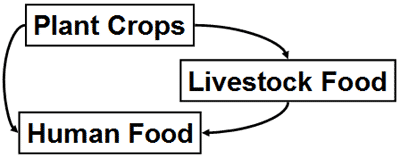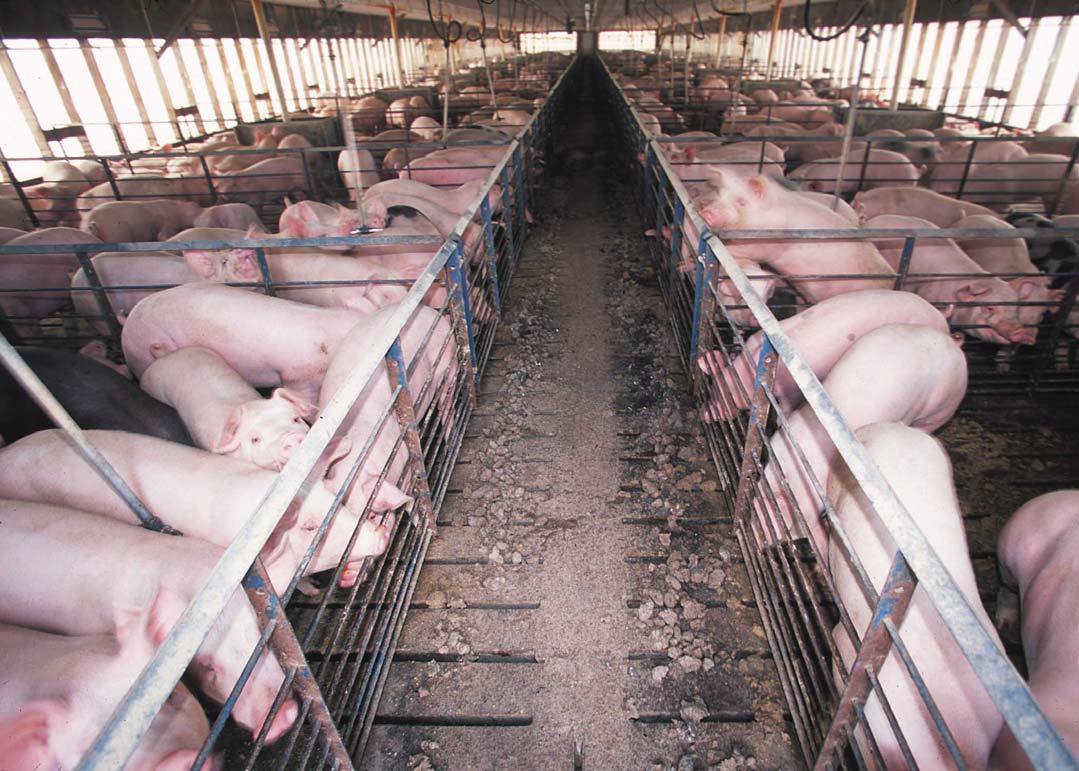37 Livestock’s Long Shadow
Thus far in the module, we have focused mainly on plant crops, but livestock is a hugely important component of the food-agriculture system. It is important for several reasons, including its inputs, its environmental impacts, its nutritional significance, and for the unique ethical issues it raises. Many of the social and environmental impacts of livestock are metaphorically dark, which is why livestock is referred to as having a large shadow. The phrase Livestock’s Long Shadow comes from a report of the United Nations Food and Agriculture Organization, which we’ll get a glimpse of below.
Inputs to Livestock
Many livestock animals graze on natural plant life, such as in the commons discussed in Module 4, but in today’s agriculture system, the majority of livestock animals are fed plants that are grown by humans. There are so many livestock animals around the world that, between grazing and plant feed, livestock takes up a very large amount of the planet’s land. The need to feed plants to livestock animals is another main reason why livestock is such an important issue. In short, we could either eat our plant crops ourselves, or we could feed the plants to livestock animals and then eat meat, eggs, and dairy from the animals:

In other words, livestock animals are higher up the food chain than plant crops are. This means that livestock needs two sets of inputs: the inputs for the animals and the inputs for the plants that they eat. In the case of carnivorous livestock animals, there would be a third or fourth set of inputs. Furthermore, animals are much less than 100% efficient at converting plant food into animal food. This means that we’ll need more than one unit of plant food as input for every unit of livestock food that we get out from it. So, a diet based on livestock will actually require more plant crops than a diet based on plants. This, in turn, means that all of the ecological and other impacts of growing plants will be amplified when we base our diets on livestock animals instead.
Consider This: Livestock’s Land Usage
The United Nations Food and Agriculture Organization (FAO) is a UN agency dedicated to addressing global hunger issues. In 2006, it released a major report, Livestock’s Long Shadow(link is external), documenting the environmental and other impacts of livestock. Here is an excerpt (from page xxi of the Executive Summary) describing livestock’s land usage:
The livestock sector is by far the single largest anthropogenic user of land. The total area occupied by grazing is equivalent to 26 percent of the ice-free terrestrial surface of the planet. In addition, the total area dedicated to feedcrop production amounts to 33 percent of the total arable land. In all, livestock production accounts for 70 percent of all agricultural land and 30 percent of the land surface of the planet.
Livestock’s large land usage is a significant, and complex issue. For example, the land usage is a main driver of deforestation around the world and of biodiversity loss.
Environmental and Health Impacts of Livestock
Some of the key environmental impacts of livestock come from the large inputs of plant food that they require. The impacts of plant crops include land usage, changes to the nitrogen and phosphorus cycles for fertilizer, and consumption of energy and water resources. There are also environmental impacts of livestock that come from the animals themselves. This includes the wastes produced by the animals themselves, in particular manure and urine.
Factory Farms
Factory farms are also known as Concentrated Animal Feeding Operations (CAFOs). A factory farm is a livestock farm designed to maximize the output of livestock products per unit cost. It is industrial agriculture for livestock.

Video Assignment: The Meatrix
The Meatrix (now a series) is a popular video about factory farming that has been translated into more than 30 languages and watched by more than 15 million people worldwide. The video does not fully acknowledge some of the complexities and nuances in today’s modern agricultural system, but the important thing to note is that there is a big difference between large agribusiness and factory farms on the one hand and small family farms on the other hand.
The Meatrix series is available at the website themeatrix.com(link is external). Please go to this website and view the video that appears in the middle of the homepage (i.e., The MEATRIX® Relaunched). The website has other videos, but these are optional for Geography 030.
Reading Assignment: Impacts of Factory Farming: “Public Health”
GRACE Communications Foundation is an environmental advocacy non-profit organization headquartered in New York City that works to increase public awareness of environmental and health issues from food, water and energy systems, and to promote a more sustainable future.
Please read the “Public Health” article from its food program, Sustainable Table®(link is external). As you read this, identify the environmental and health impacts from factory farms. In addition, you might recall from the Module 2 discussion of biogas generators that the generators use animal manure as inputs. So, can we reduce pollution from livestock farms – whether they’re factory farms or not – by converting the waste into biogas?
Livestock Animal Treatment
As indicated in The Meatrix video, a major issue raised by livestock is in the treatment of livestock animals. These animals are often treated very poorly. If we care about the animals for their own sake, then we will care about how they are treated in factory farms and elsewhere. This relates to the ethics concepts of speciesism and anthropocentrism as discussed in Module 3. On speciesism, philosopher Jeremy Bentham wrote, The question is not, Can they reason? nor Can they talk? but, Can they suffer?
For better or worse, there is quite a lot of suffering experienced by livestock animals, especially those in factory farms. Because of this, there are people who advocate against consuming the products of factory farms. If we boycott these products, then the animals’ conditions will change. This, combined with the environmental and public health impacts of livestock, are two primary reasons that some people choose vegan or vegetarian diets, or reduce their consumption of animal products within an omnivorous diet. We’ll discuss food choice later in this module, but for now, please consider the issues raised by your own choices of which foods to eat.

